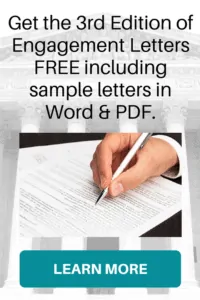Practical Considerations in Representing the (Un)Happily Married (Pt. 1 of 3)
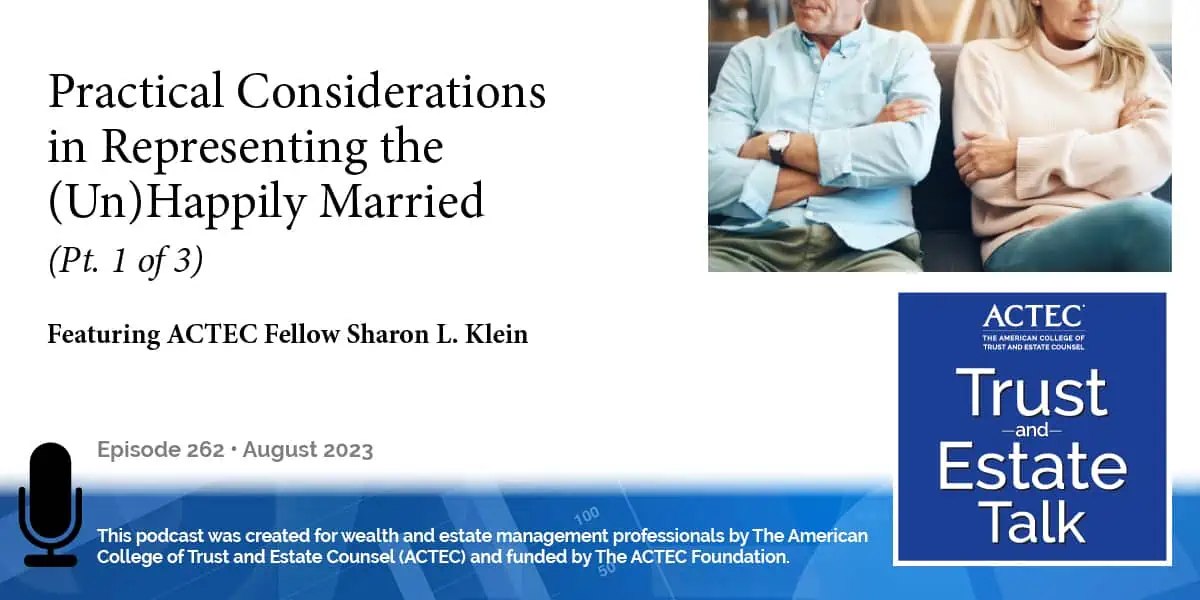
“Practical Considerations in Representing the (Un)Happily Married” is a three-part special:
- Part 1, posted August 15, 2023 (this podcast)
- Part 2, posted August 22, 2023
- Part 3, posted August 29, 2023
“Practical Considerations in Representing the (Un)Happily Married,” that’s the subject of today’s ACTEC Trust and Estate Talk.
Transcript/Show Notes
This is Travis Hayes, ACTEC Fellow from Naples, Florida. Estate planners often encounter challenging issues when representing married couples. ACTEC Fellow Sharon Klein of New York City will address practical considerations in representing once happily married couples who may now be headed toward divorce, and whether trust assets will be accessible by a former spouse as a result of that divorce.
In Part 1 of this three-part series, Sharon will discuss the starting point for analyzing whether trust assets could be on the table in the divorce proceedings, which is reviewing the terms of the applicable trust agreement. Welcome, Sharon.
Introduction to Trust Assets in Divorce Proceedings Podcast Series
Sharon Klein: Thanks so much, Travis. It’s my pleasure to be here. Thank you for the warm welcome, and I’m delighted to welcome our listeners to Part 1 in this three-part series dealing with unhappily married couples. And, of course, if you’re dealing with high net worth couples, often on a high net worth balance sheet are trusts. And so, the series will address the question of whether trust assets are reachable in divorce. And to determine whether trust assets are accessible in divorce, the key question is generally whether the interest of the beneficiary spouse is a property interest that can be considered an asset under the relevant state’s law.
So, in Part 1, we’re going to examine what to look for in the governing instrument to see if trust assets are vulnerable in divorce. In Part 2, we’re going to examine what to look for in terms of the history of how the trust has been administered. And in Part 3, we’re going to explore tax traps, creative planning techniques, and practice tips.
Key Questions to Ask in Reviewing Trust Agreements
So, as we begin our Part 1 discussion, I’m reminded of the old adage, “when all else fails, read the instructions,” because the first thing you need to do is to look at the terms of the trust agreement. And while much is going to depend on state law, in terms of whether a beneficiary’s interest can be considered in a divorce proceeding, the starting point is always going to be to determine the nature of the trust interest.
And the bottom line is that the less chance a trust beneficiary will receive a trust distribution, and the less control of trust assets that the beneficiary has, the less likely that their trust interests are going to be reachable in divorce. And, as you review the trust document, I’ve devised what I think are eight key questions to ask to determine if you may be able to access trust assets in a divorce.
Who Created the Trust?
Question No. 1 is: Who created the trust? Courts are less likely to consider a trust created by a third party as part of the marital estate. So, with a trust, for example, created by a parent or a grandparent — because that’s more likely to have been done as legitimate estate planning — as opposed to a spouse creating a trust, which may be seen as trying to shelter assets in anticipation of a divorce. Because, let’s face it, it’s just more suspicious if a spouse transfers assets to a trust and then says, “sorry, those assets are no longer part of the marital estate.”
Who Are the Beneficiaries?
Question No. 2 is: Who are the beneficiaries? If the trust includes a class of beneficiaries, including multiple people over several generations, and particularly if it’s a so-called “open class of beneficiaries” — in other words, the class includes beneficiaries who are not yet born, such as future issue — that leaves the total number of potential beneficiaries undeterminable. If that’s the situation with a very broad class, it will be less likely that the beneficiary spouse, who is one of many beneficiaries, will receive trust distributions. Contrast that to the situation where the beneficiary spouse is the sole beneficiary, then more likely to receive distributions. And so, with the broad class, it’s less likely that the trust interests will be reachable in divorce.
On What Basis Can Trustees Make Distributions?
Question No. 3 is: On what basis can trustees make distributions? And this one is key to determining if there is a property interest. If a trustee is given broad authority to make distributions within its sole discretion, then the timing of the distributions and the amount of the distributions is going to be uncertain. And it’s less likely that a court will find that type of discretionary interest reachable in divorce.
As opposed to, for example, if the trustee is required to pay income or required to pay a portion of the principal to the beneficiary. Because if the trustee is required to pay out income, or if the trustee is required to pay out principal, pursuant to an ascertainable standard like HEMS – health, education, maintenance, and support – then it’s likely that the beneficiary will have a right to compel trust distributions in accordance with the trust terms. And then it’s likely – at least up to the amount the beneficiary’s entitled to receive – that those assets will be includable in the divorce balance sheet.
Is There a Spendthrift Provision?
Question No. 4 is: Is there a spendthrift provision? A spendthrift clause is commonly inserted in trust documents as a form of creditor protection. It basically prohibits a beneficiary from transferring their interest in the trust, and it provides that a beneficiary’s interests will not be subject to that person’s debts or liabilities. And the bottom line is that creditors – and the next spouse, of course, is the quintessential creditor — creditors must wait until a distribution is made to a beneficiary before they can assert any claims against those assets.
So, if you’re representing a trust beneficiary, it’s very helpful to find a spendthrift clause. But it’s not foolproof, because trust funds have often been factored into the analysis despite the presence of a spendthrift clause where, for example, courts have equalized the non-beneficiary spouse with assets outside of the trust.
Does a Beneficiary Have Control Powers?
Question No. 5 is: Does a beneficiary have control powers? And the cases show that the greater the powers of the beneficiary to exert control over a trust, the greater the likelihood that a court is going to consider the beneficiary’s interest in a divorce proceeding.
This issue is particularly interesting to me because I don’t think that planners are necessarily focused on how these control features may make a trust more vulnerable in divorce. Planners are generally focused on how to maximize and safeguard the transfer of wealth, and usually, that means not gifting outright. Usually, that means making gifts in trust, while wanting the beneficiary to understand that the assets have passed in trust, typically not because the creator doesn’t love or trust the beneficiary, but for planning purposes. They want to have the assets in trust for protection, while at the same time giving the beneficiary the maximum amount of control possible without triggering adverse tax consequences. But beware: those family law attorneys will try to take the supposedly innocuous control features and try to turn them into arguments about why those control features make trust assets reachable in divorce. Who knew? Well, that’s what happens.
What control features am I referring to? Well, they might include the beneficiary’s acting as a trustee. Perhaps, even the beneficiary’s ability to make distributions to themselves, pursuant to a standard like HEMS – health, education, maintenance, and support – which is often used because it doesn’t have adverse tax consequences.
Other control features might include having the power to remove and replace trustees or having a so-called “power of appointment,” which allows the beneficiary to direct the further disposition of the trust assets, either during lifetime or at death. And the greater the amount of control, the more likely that the matrimonial lawyer will try to make an argument that the beneficiary had so much control that the trust was the alter-ego of the beneficiary, and that the trust assets should be included in the marital balance sheet.
Is the Settlor’s Intent Clear?
Moving on to question No. 6, which is: Is the settlor’s intent clear? Under both common-law principles and the Uniform Trust Code, it is axiomatic that the settlor’s intent is paramount. And the settlor’s intent has often been a key consideration for the courts, particularly in cases, for example, where the settlor’s intent is expressly stated to be that the trust assets should not be treated as marital property, or counted as assets available to a beneficiary in a divorce action.
Who is the Trustee?
Question No. 7 is: Who is the trustee? Is it Uncle Joe? Or the beneficiary’s college roommate? Or is the trustee an independent trustee? If you have an independent, neutral trustee acting – particularly if it’s a corporate trustee – that usually removes even the appearance of impropriety, and can help circumvent suspicion that a family member or friend acting as a trustee is manipulating trust distributions for the benefit of a trust beneficiary.
Is “Spouse” Defined?
Final question, question No. 8 is: Is “spouse” defined? Now, particularly in the context of trusts that are created by parties to the marriage, if one spouse creates a trust for the benefit of the other, the first thing that you should do is look at the definition of “spouse.” Some documents make it clear that a divorced spouse will cease to be a beneficiary, by using a floating-spouse concept – which is a flexible definition and means the spouse to whom the trust creator is married from time to time. And that flexible definition can adjust and readjust after every marriage, divorce, marriage, divorce, and so on and so forth.
But, some trust and estate attorneys tell me it doesn’t engender the warmest of feelings if you have the happy couple sitting opposite you, and one spouse knows, for example, that not only will she be out in the event of divorce, but that her husband’s next wife is going to step into her shoes. So, while that floating-spouse concept does work, other attorneys find it more palatable to name the current spouse, but with a proviso. The proviso being that the spouse and the trust creator remain married and living together for the spouse to remain a beneficiary.
So, whatever definition you use, it’s very important to have a definition in the trust document because, in the absence of guidance in the document, courts can search for the creator’s intent by examining the trust provisions. And you might not end up with a result that reflects the actual intent.
So, the practice tip here is: if you’re drafting trust documents for a married couple, it’s very wise to ensure that the settlor defines what is meant by the term “spouse” in the event of a divorce. And additionally, whether a spouse is out as beneficiary in the event of divorce has huge tax consequences, for reasons we’ll get into in an upcoming podcast episode.
So, once you’ve reviewed the trust document, that’s only half the picture. The other half of the picture is that you have to look at what actually happened, and you have to consider the history of trust administration, which will be the subject of Part 2 of this podcast series.
Travis Hayes: Thank you, Sharon, for discussing issues relating to the accessibility of trust assets in a divorce. Stay tuned for Parts 2 and 3 of ACTEC’s ongoing series on this topic.
You may also be interested in:
Latest ACTEC Trust and Estate Talk Podcasts
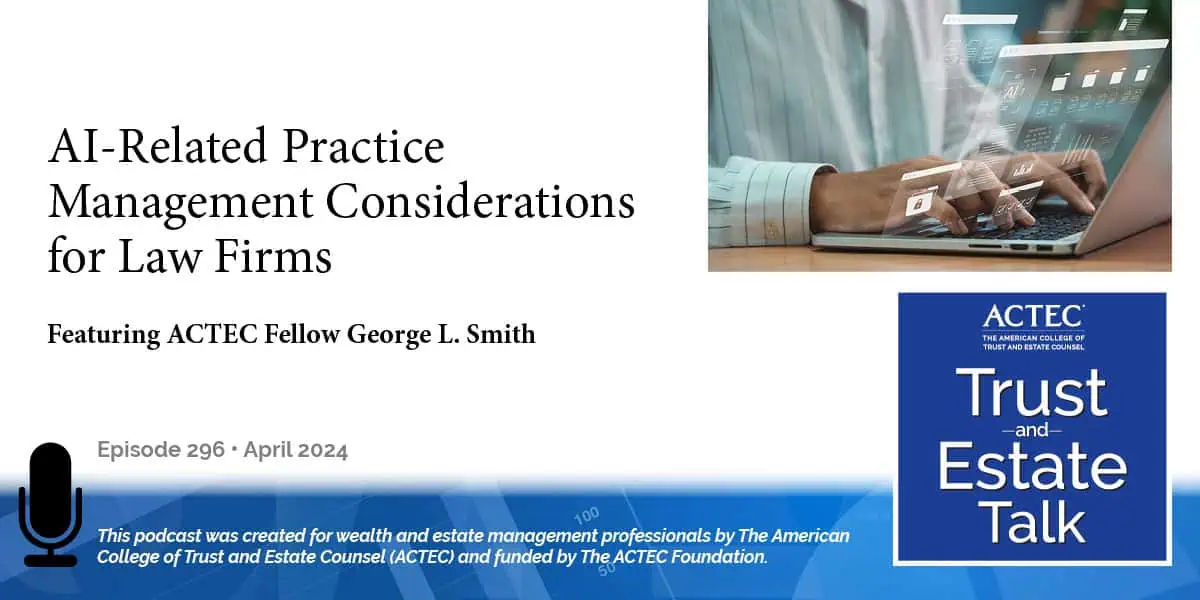
AI-Related Practice Management Considerations for Law Firms
A discussion for law firms about how to incorporate AI in their practice management, including staff considerations, the “billable hour,” and more.
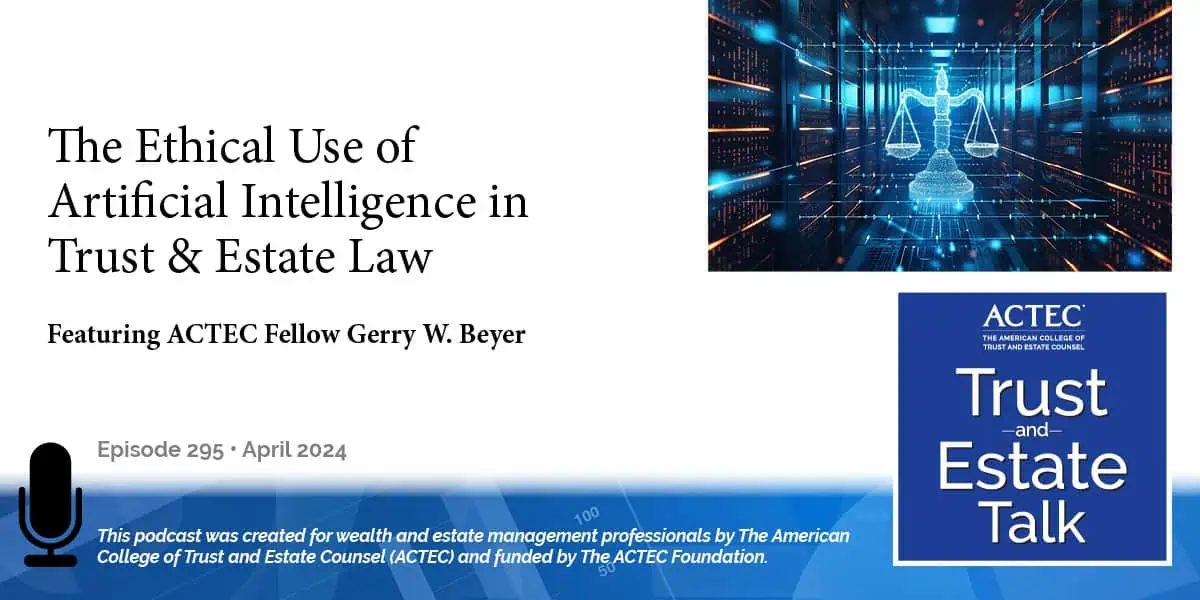
The Ethical Use of Artificial Intelligence in Trust & Estate Law
A law professor offers insights into the risks, rewards, duties and ethical considerations of lawyers using AI in their T&E practices.
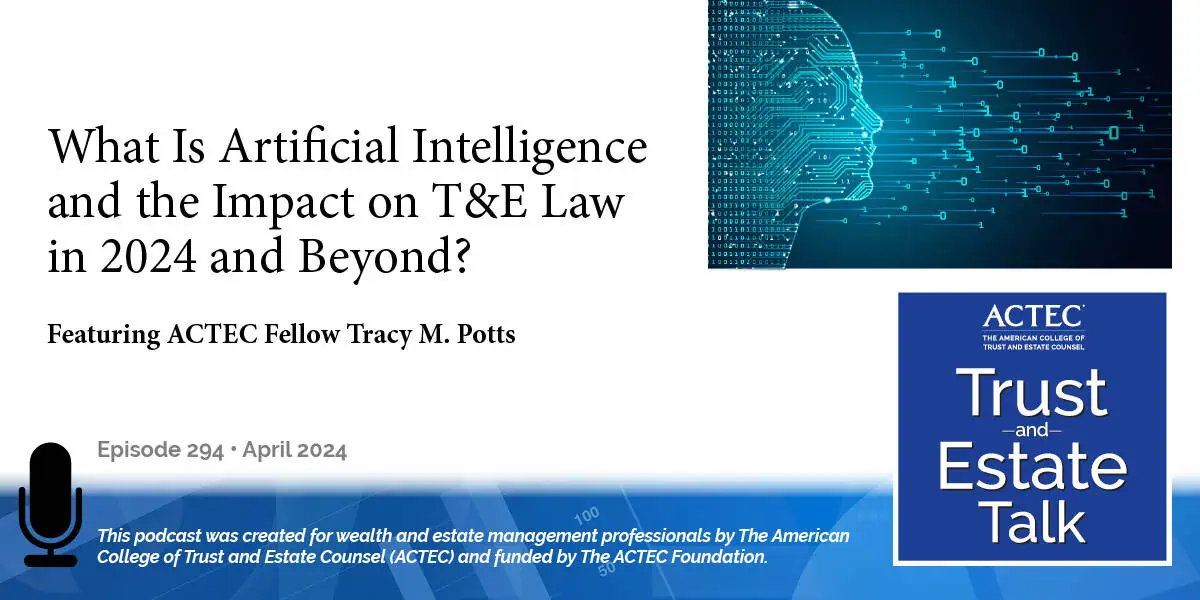
What Is Artificial Intelligence and the Impact on T&E Law in 2024 and Beyond?
A primer on the types and uses of AI, then a deeper dive into the impact on trust and estate law from types to applications to ethical considerations.

